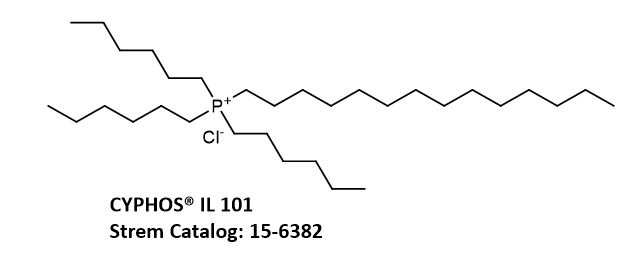'Product Blog'
A Suitable Candidate for Complete Extraction of Three Targeted Metals
CYPHOS® IL 101 can be advantageously used as an extractant to recover individually palladium, platinum, and rhodium from acidic chloride feed solutions
Tetraalkylphosphonium chlorides are readily available on a large scale and currently Solvay, in collaboration with the Strem Catalog by Ascensus Specialties, offers a number in different forms [1]. One of the phosphonium chlorides in that offering is trihexyl(tetradecyl)phosphonium chloride marketed by Solvay as CYPHOS® IL 101 (CAS: 258864-54-9, Strem Catalog: 15-6382) [2]:

The preparation of CYPHOS® IL 101 by reacting trihexylphosphine and 1-chlorotetradecane at 140 0C was first reported in 2003 [3]. Since then, this room-temperature phosphonium ionic liquid (PIL) has attracted a great deal of attention. This interest is attested to by the largest number of references (>1100) retrieved by SciFinder in comparison with any other phosphonium chloride.
There is no doubt that this interest has been prompted by the fact that CYPHOS® IL 101 is a room-temperature ionic liquid (RTIL) with Tg -57.9 0C [4] and is being commercially available on a large scale.
There is an excellent review published in 2011 [5] concerning the field of chemical and environmental engineering which covered the literature on two “cost-saving precursors”, including CYPHOS® IL 101, up to 2010.
It should be mentioned here that in most of the studies CYPHOS® IL 101 was supplied by Cytec/Solvay and was used as received. However, in several instances supplied CYPHOS® IL 101 was additionally purified and/or was prepared by the authors. In those cases, instead of the trade name CYPHOS® IL 101 we will be using the name as appeared in the publication (i.e. trihexyltetradecylphosphonium chloride or [THTDP]Cl).
Thus, CYPHOS® IL 101 is a hydrophobic RTIL with high thermal stability [6]. Thermal stability of CYPHOS® IL 101 was further studied in greater detail [7]. Of special interest in that study are the insights into the behavior of this IL at high temperatures which is relevant for high-temperature industrial processes.
A comprehensive structural and spectroscopic characterization of trihexyltetradecylphosphonium chloride was conducted by combining experiments with density functional theory (DFT) calculations [8]. Results offered complete identification of experimental spectroscopic features of trihexyl(tetradecyl)phosphonium chloride (also referred to as [P666(14)][Cl]) and it was concluded that they can be applied to other similar phosphonium ILs.
The largest number of publications related to CYPHOS® IL 101 (close to 890) appeared after 2010. Thus, it is very challenging to provide a comprehensive review and we will mention here a handful of interesting publications mainly after 2010 but only focusing this time on the use of this remarkable PIL for desulfurization of fuels and extraction of platinum group metals.
Desulfurization of fuels
The current industrial method for removal of sulfur from fuels is hydrodesulfurization (HDS), which is a very costly option. Ionic liquids are one of the options extensively studied for extraction of oxidized S-compounds (oxidative desulfurization, ODS) or for direct extraction of S-compounds (extractive desulfurization, EDS) [9]. Recently [THTDP]Cl (prepared by the authors in house) was shown to be the most promising solvent for removal of DBT (dibenzothiophene) containing fuels and could achieve 81.5% removal efficiency in single stage extraction at 30◦C in 30 min with mass ratio 1:1. It was additionally shown that [THTDP]Cl can be reused up to five cycles without regeneration and even more cycles after a regeneration process. The authors concluded that the results demonstrated the remarkable advancement of EDS (more economical) over the HDS process [10].
In a more recent publication [THTDP]Cl was applied as an effective catalyst/extractant in the ultrasound-assisted extractive/oxidative desulfurization (UEODS) process and a liquid–liquid catalytic ODS process. In summary, the application of [THTDP]Cl as a catalyst/extractant in the UEODS of a MO (model oil) and base oil was described. The findings of the desulfurization indicated that [THTDP]Cl had better catalytic performance for the oxidative desulfurization of MO ( as well as base oil using hydrogen peroxide as the oxidant). The results suggested applicability of the process to industrial applications [11].
Extraction of Platinum Group Metals (Pt, Pd, Rh)
Recovery of platinum group metals from spent materials is becoming increasingly important due to the high value of these metals and their progressive depletion. Thus, over 99% of the palladium(II) was effectively extracted with CYPHOS® IL 101 from 0.1 M HCl in the presence of nickel(II), copper(II), lead(II), iron(III), rhodium(III) and ruthenium(III), while <10% of the other metals was transported to the organic phase. Separation of palladium(II) from platinum(IV) was not so effective, and about 70-75% of the palladium(II) and 60-68% of the platinum(IV) were extracted [12].
It was shown that CYPHOS® IL 101 can be advantageously used as extractant to recover individually palladium, platinum, and rhodium from acidic chloride feed solutions [13].
Extraction and separation of platinum(IV) and palladium(II) from a hydrochloric acid solution was examined with a mixture of undiluted ionic liquids, 1-methyl-3-octylimidazolium bis(trifluoromethylsulfonyl)imide ([C8mim][Tf2N]) and CYPHOS® IL 101. [C8mim][Tf2N] showed a high selectivity for platinum(VI), whereas CYPHOS® IL 101 had a high extraction ability for both platinum(IV) and palladium(II). The addition of CYPHOS® IL 101 to [C8mim][Tf2N] improved the extraction efficiency for platinum as well as the separation factor between platinum and palladium. The ionic liquid mixture was shown to be reusable for at least five extraction cycles [14].
CYPHOS® IL 101 was evaluated for its ability to extract platinum, palladium, and rhodium from a spent car catalyst previously leached into a choline-based deep eutectic solvent (DES) and it was concluded that this PIL was a suitable candidate for complete extraction of all three targeted metals [15].
References:
- Strem’s product blog
- CYPHOS® IL 101 VERSATILE PHOSPHONIUM IONIC LIQUID
- Green Chem. 2003, 5 (2), 143-152.
- RSC Adv., 2016, 6, 88979–88990.
- Ionic liquids in chemical engineering
- Aust. J. Chem. 2009, 62, 309–321.
- Phys. Chem. Chem. Phys. 2018, 20, 4, 2444-2456.
- ChemistrySelect 2016, 1(4), 741-747.
- RSC Adv. 2012, 2, 759–783.
- Chem. Eng. Res. Des. 2018, 133, 388-397.
- Environ. Technol. Innov. 2021, 24, 101965.
- Sep. Purif. Technol. 2011, 80 (2), 385-389.
- RSC Advances 2016, 6 (67), 62717-62728.
- Solvent Extr. Res. Dev. 2017, 24, 97-104.
- Molecules 2021, 26 (23), 7204.
Featured Product
15-6382 Trihexyl(tetradecyl)phosphonium chloride, min. 95% CYPHOS IL 101 (258864-54-9)
Related Products
All products sold in collaboration with Solvay
Phosphorus Ligands and Compounds Booklet






